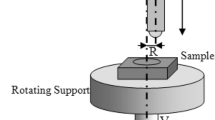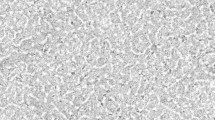Abstract—
The possibility of increase in Ti6A14V alloy’s wear resistance is shown using cathodic plasma electrolytic nitriding in a solution of ammonium chloride and ammonia. A competing effect on the surface erosion was revealed under the discharges and high-temperature oxidation on the surface morphology and roughness. The complex effect was established on the surface roughness and surface layer hardness of the titanium alloy’s wear resistance. It was determined that the highest decrease in the mass wear by 2.7 times was observed in the samples with a maximum microhardness of the surface layer, reaching 820 HV, and the lowest roughness of the surface. It was shown that the friction coefficient decreased proportionally to the treatment duration, when the surface layer was of not-too-high hardness that benefits the counterbody’s sliding motion.







Similar content being viewed by others
REFERENCES
Yerokhin, A.L., Nie, X., Leyland, A., Matthews, A., et al., Plasma electrolysis for surface engineering, Surf. Coat. Technol., 1999, vol. 122, p. 73.
Kusmanov, S.A., Smirnov, A.A., Silkin, S.A., Parfenyuk, V.I., et al., Plasma electrolytic nitriding alfa- and beta-titanium alloy in ammonia-based electrolyte, Surf. Coat. Technol., 2016, vol. 307, p. 1291.
Kusmanov, S.A., Dyakov, I.G., Belkin, P.N., Gracheva, L.A., et al., Plasma electrolytic modification of the VT1–0 titanium alloy surface, J. Surf. Invest.: X-ray, Synchrotron. Neutron. Tech., 2015, vol. 9, no. 1, p. 98.
Belkin, P.N., Borisov, A.M., Vostrikov, V.G., Dyakov, I.G., et al., Application of proton NBS spectrometry for the study of anodic thermochemical treatment of titanium, Phys. Chem. Mater. Process., 2006, no. 1, p. 59.
Belkin, P.N., Zhirov, A.V., Belkin, V.S., Parfenyuk, V.I., et al., Anode plasma electrolytic saturation of titanium alloys with nitrogen and oxygen, J. Mater. Sci. Technol., 2016, vol. 32, p. 1027.
Belkin, P.N., Borisov, A.M., and Kusmanov, S.A., Plasma electrolytic saturation of titanium and its alloys with light elements, J. Surf. Invest.: X-ray, Synchrotron. Neutron. Tech., 2016, vol. 10, no. 3, p. 516.
Aliofkhazraei, M., Taheri, P., Sabour Rouhaghdam, A., and Dehghanian, C., Study of nanocrystalline plasma electrolytic carbonitriding for CP-Ti, Mater. Sci., 2007, vol. 43, no. 6, p. 791.
Aliofkhazraei, M., Salasi, M., Sabour Rouhaghdam, A., and Taheri P., Electrochemical study of nanocrystalline plasma electrolytic carbonitriding of CP-Ti, Anti-Corr. Meth. Mater., 2007, vol. 54, no. 6, p. 367.
Huang, J., Fan, X., **ong, D., Li, J., et al., Characterization and one-step synthesis of hydroxyapatite-Ti(C,N)-TiO2 composite coating by cathodic plasma electrolytic saturation and accompanying electrochemical deposition on titanium alloy, Surf. Coat. Technol., 2017, vol. 324, p. 463.
Blashchuk, V.E., Lavrovskaya, I.B., Onoprienko, L.M., Belkin, P.N., et al., Improving the corrosion resistance of low alloy titanium alloys by nitriding in an electrolyte, Surf. Eng. Appl. Electrochem., 1989, no. 5, p. 18.
Belkin, P.N., Kusmanov, S.A., and Belkin, V.S., Increase in corrosion resistance of commercial pure titanium by anode plasma electrolytic nitriding, Mat. Sci. Forum, 2016, vol. 844, p. 125.
Li, X.-M. and Han, Y., Mechanical properties of Ti(C0.7N0.3) film produced by plasma electrolytic carbonitriding of Ti6Al4V alloy, Appl. Surf. Sci., 2008, vol. 254, p. 6350.
Qin, Y., **ong, D., Li, J., and Tyagi, R., Corrosion and bio-tribological properties of Ti(CN)x hard coating on titanium alloy by the pulsed plasma electrolytic carbonitriding process, Tribol. Int., 2015, vol. 82, p. 543.
Smirnov, A.A., Kusmanov, S.A., Kusmanova, I.A., and Belkin, P.N., Effect of electrolyte depletion on the characteristics of the anodic plasma electrolytic nitriding of a VT22 titanium alloy, Surf. Eng. Appl. Electrochem., 2017, vol. 53, no. 5, p. 413.
Funding
This study was supported by the Russian Science Foundation (grant no. 18-79-10094).
Author information
Authors and Affiliations
Corresponding author
Ethics declarations
The authors declare that they have no conflicts of interest.
Additional information
Translated by M. Baznat
About this article
Cite this article
Kusmanov, S.A., Tambovskii, I.V., Korableva, S.S. et al. Wear Resistance Increase in Ti6Al4V Titanium Alloy Using a Cathodic Plasma Electrolytic Nitriding. Surf. Engin. Appl.Electrochem. 58, 451–455 (2022). https://doi.org/10.3103/S1068375522050088
Received:
Revised:
Accepted:
Published:
Issue Date:
DOI: https://doi.org/10.3103/S1068375522050088




